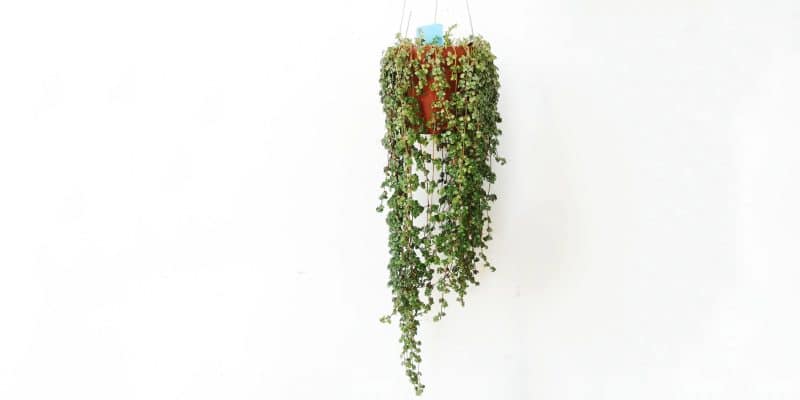If Pilea Glauca catches your eye with its delicate, cascading foliage and silvery-blue leaves, you’re not alone.
This trailing beauty — also affectionately known as the Silver Sprinkles plant — will add a dash of charm and whimsy to your living space. In this article, we’ll provide you with essential tips and tricks for Pilea Glauca care. Because, let’s face it, we could all do with a little more magic in our lives.
Table of Contents
Pilea Glauca Plant Care Guide
History, Habitat, and Characteristics
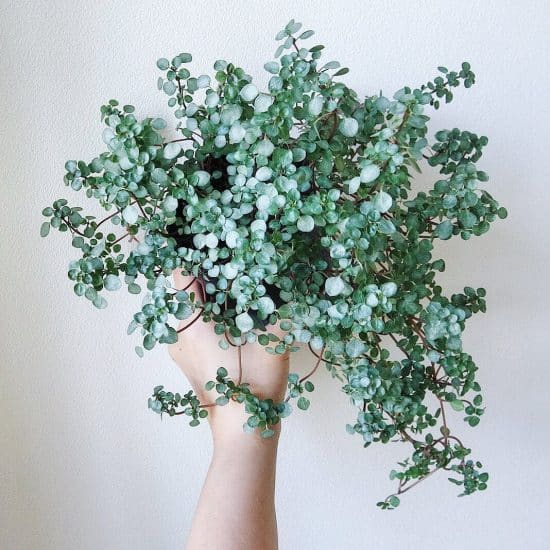
Pilea Glauca (Pilea libanensis) hails from tropical regions of Central and South America, including Mexico. It features captivating silvery leaves and enchanting red stems that have won the hearts of many.
This tropical plant is part of the Urticaceae family, which boasts over 700 species of flowering plants. Pilea Glauca stands out from its relatives with its distinctive foliage that shimmers like a little disco ball when exposed to ample light. Talk about stealing the spotlight!
The red stems of Pilea Glauca provide a striking contrast to its grey foliage, creating a mesmerizing visual effect. This extraordinary combination has earned the plant various nicknames, including Silver Sparkles, Grey Baby Tears, Grey Artillery Plant, and Red Stem Pilea.
Besides being a great houseplant, you might notice Pilea Glauca planted in outdoor landscapes. It is often used as a ground cover due to its low-growing nature and ability to grow rapidly — practical attributes that have made it popular for landscaping projects worldwide.
Similar Plants
Besides different varieties of Pilea Glauca available on the market, the most popular being ‘Aquamarine’, there are many other species of Pilea to consider for your indoor garden.
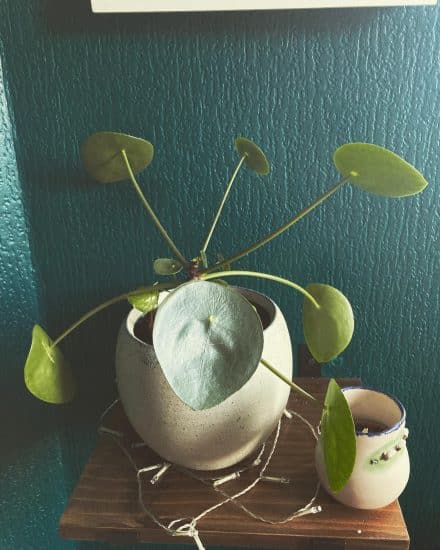
Chinese Money Plant (Pilea peperomioides): Recognizable for its round, pancake-like leaves and prominent central stem.
Aluminum Plant (Pilea cadierei): Featuring dark green leaves with silver markings, this pilea has an eye-catching, metallic appearance.
Friendship Plant (Pilea involucrata): This species boasts lovely green, quilted leaves with deep purple undersides.
Is Pilea Glauca the same as Pilea Glaucophylla?
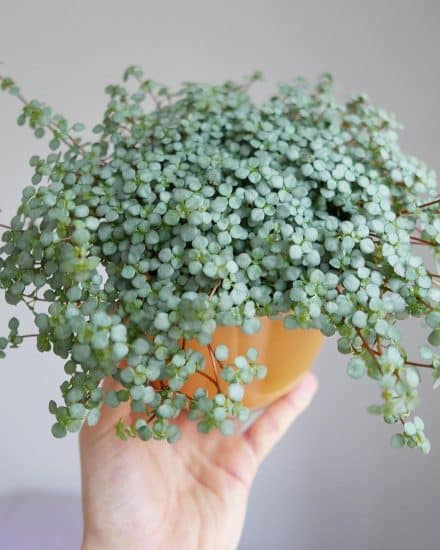
Not quite.
The plant, known as silver sprinkles or gray artillery plant, has a confusing botanical identity. Often called Pilea glaucophylla or Pilea Glauca, the latter has never been officially published in a reputable botanical database, making it a nomen nudum, which means it lacks a “type” specimen or a legitimate publication to support its validity. In contrast, Pilea glaucophylla is a legitimate species published in 1936 with a Colombian type specimen.
Upon closer inspection, plants sold online as Pilea Glauca differ from the Pilea glaucophylla type specimen, and many supposed Pilea glaucophylla are actually Pilea Glauca. The probable true identity is Pilea libanensis, native to Cuba. To be accurate, it’s best to call this plant Pilea libanensis, but we await the botanists to make that clear distinction.
Light
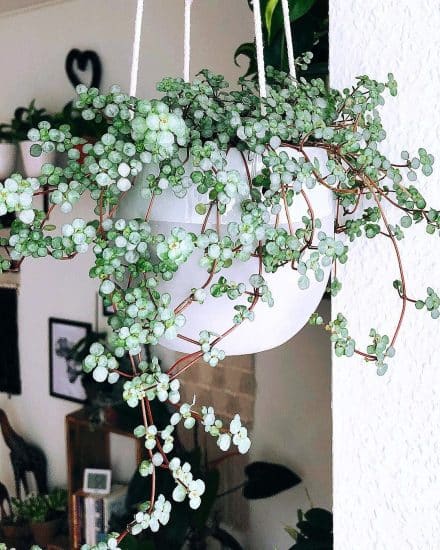
When it comes to lighting requirements for the delightful Pilea ‘Silver Sparkle’, it’s good to consider its natural growing conditions.
This attractive trailing plant flourishes in bright light while avoiding harsh, direct sunlight. To maintain its lush appearance, place your Pilea Glauca near a window where it can enjoy early morning sun and indirect light throughout the day.
If your Pilea Glauca is getting too much light, its leaves may turn yellow or even get scorched. If you spot these signs, try adjusting the plant’s position by moving it further from the window or utilizing a sheer curtain to soften the sunlight.
Conversely, if your plant shows signs of light deficiency, such as slow growth or leggy stems, it’s time to offer more indirect sunlight. A southeast-facing window, situated a few feet away from the glass, is an excellent choice.
Water
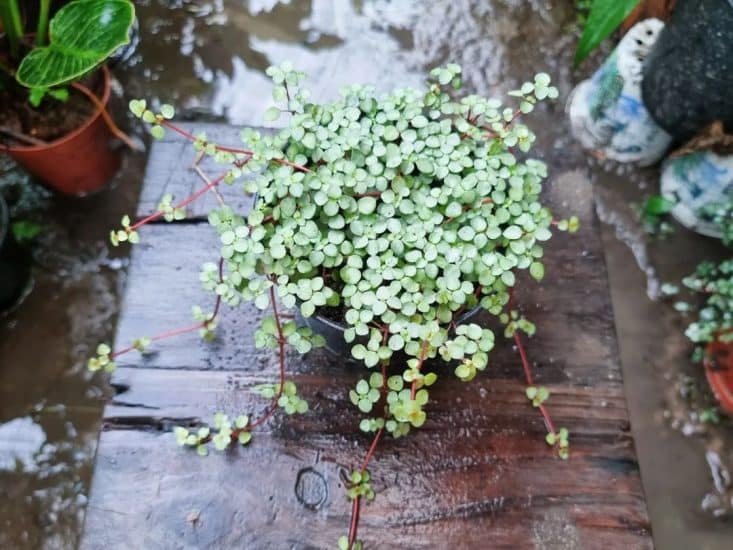
Caring for your Pilea Glauca’s water needs can be a bit challenging due to its delicate leaves and tropical nature.
We recommend the bottom watering method for this plant, which will protect its tender leaves while ensuring the roots receive adequate water from below. Aim to keep the soil evenly moist but not soggy. Let the soil to dry out slightly between waterings without allowing it to become completely dry. During the spring and summer months, you can expect to water your Pilea Glauca approximately once a week.
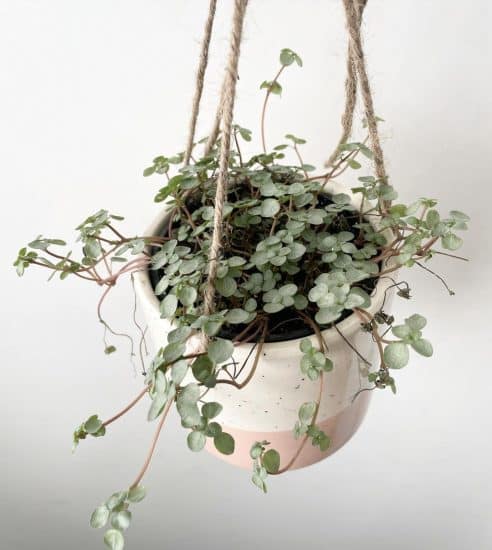
Not receiving enough water? Your Pilea Glauca might start dropping leaves or showing curled-up foliage. To remedy this, simply increase your watering frequency to keep the plant hydrated and healthy.
On the other hand, too much water can cause yellowing leaves, mushy stems, or consistently wet soil. If you notice these signs or detect root rot, cut back on your watering frequency to allow the soil to dry out a bit more between each watering.
Keep in mind that if your Pilea Glauca is placed in a bright spot, it might need more frequent watering to maintain optimal moisture levels. To avoid potential damage caused by salts and minerals in tap water, you might consider using filtered or distilled water instead.
Temperature and Humidity
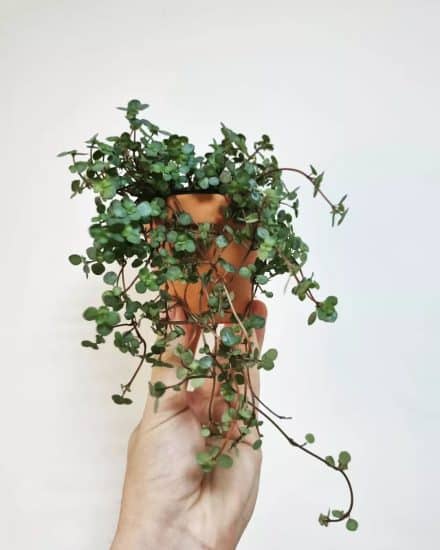
Pilea Glauca can flourish in temperatures ranging from 54-77°F (12-25°C). However, be mindful that this plant is not cold-tolerant and prefers warm temperatures. If you notice wilting or drooping leaves, this could be a sign that the temperature is either too high or too low.
As for humidity, Pilea Glauca thrives in average household conditions, ideally around 50-60% humidity. Browning leaf tips or edges might indicate that your plant needs more humidity, in which case you can boost humidity levels through a few different options.
To raise humidity:
- Place your Pilea Glauca near other tropical plants so they can benefit from moisture produced through transpiration.
- Use a pebble tray: The evaporating water can increase humidity by as much as 4-7% around the plant.
- Invest in a humidifier to maintain optimal humidity levels, especially during dry seasons or in low humidity environments.
Soil and Planting
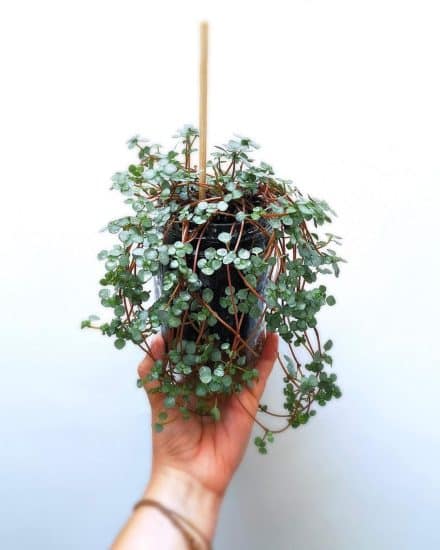
Pilea Glauca thrives when planted a well-draining soil mix that retains moisture without becoming soggy.
To create an ideal soil mix for your Pilea Glauca, start by combining equal parts organic soil and perlite. The organic soil provides a nutrient-rich base essential for the plant’s growth, while perlite helps improve soil aeration and drainage, preventing overwatering issues.
If you prefer to use a store-bought mix, a general all-purpose potting soil will work well, or a cactus mix can also be a good option (especially if you tend to be a heavier waterer). You may consider adding extra perlite or even orchid bark to improve drainage if needed.
Repotting
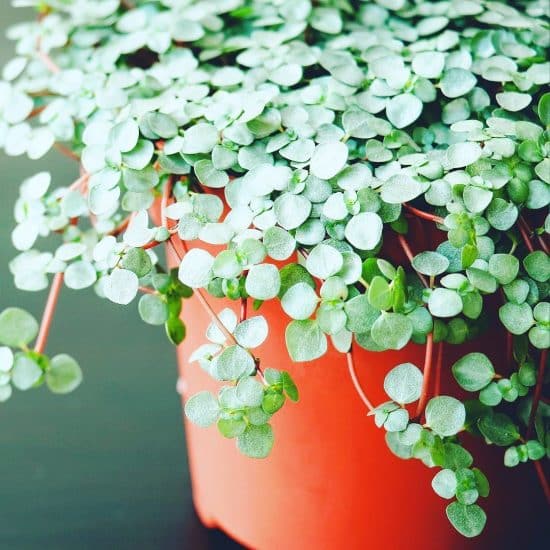
Pilea Glauca may need repotting every couple of years or when it outgrows its current container. Choose a slightly larger pot with drainage holes (this is essential to prevent rot issues). Spring is the best time to repot, as your plant will be actively growing and more resilient during this time.
To repot, gently remove the Pilea Glauca from its current pot, taking care not to damage the roots. Place the plant in its new container (making sure it has drainage holes) and surround it with the ideal soil mix.
Fertilizer
During the active growing months of spring and summer, it’s crucial to feed your Pilea Glauca with a balanced or slightly nitrogen-heavy liquid fertilizer. Opt for a fertilizer that can be diluted to avoid damaging the delicate root system.
Signs that your plant might be receiving too much fertilizer include yellow leaves, burned leaf tips, or stunted growth. To fix this issue, flush the soil with clean tap water and reduce the frequency or strength of fertilizing (your plant will thank you).
Propagation
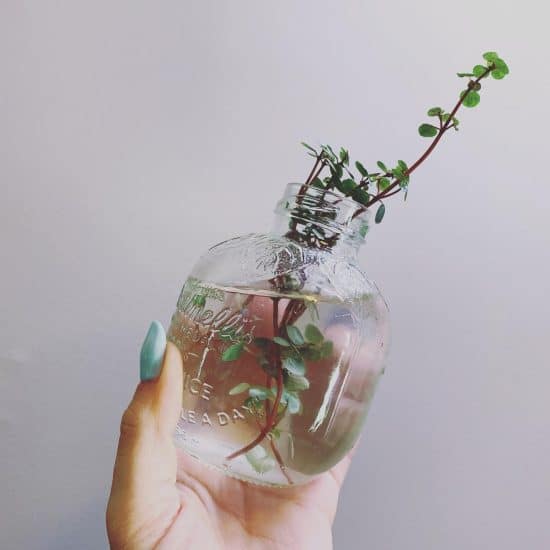
Propagating Pilea Glauca is a fun and rewarding way to grow your plant family or share the plant love with your friends. You can choose between stem cuttings in water or using sphagnum moss with the butterfly method.
Propagating Pilea Glauca via stem cuttings:
- Gather the essentials. First up, get everything you need for the job: sterilized gardening shears, a container of water or sphagnum moss, and a healthy Pilea Glauca mother plant.
- Snip those stem cuttings! Look for a strong, mature stem, making sure it has at least one node and several leaves. With your sterilized shears, cut a 4-6 inch section, ideally just below a leaf node.
- Take off the bottom leaves. Gently remove a few leaves from the lower part of the cutting, but keep at least two to three top leaves. This will help the cutting grow roots and new leaves more easily.
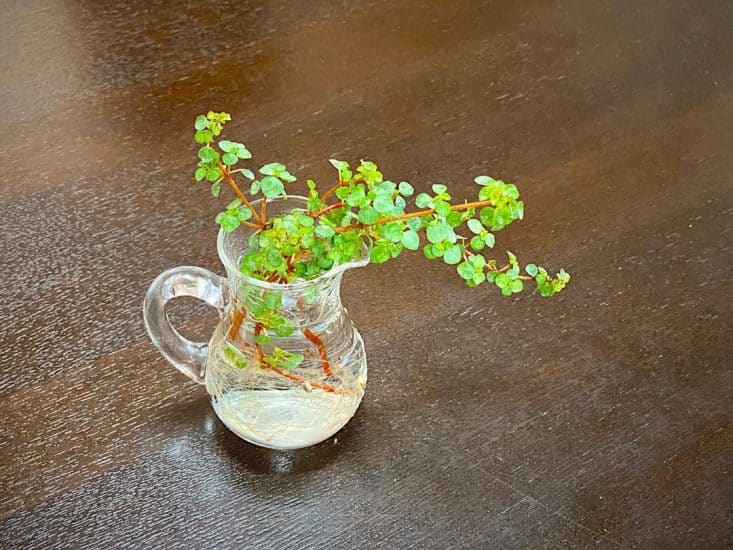
Water propagation:
- Pop the cutting in water. Fill a small container with filtered water or rainwater and place the stem cutting inside, keeping the bottom nodes submerged. Find a spot with bright, indirect light for your little water baby.
- Keep the water fresh. Swap the water in the container every 2-3 days to keep it clean.
- Check on root growth. Keep an eye out for new roots, which should appear in a few weeks. When the roots are about 2 inches long, you can plant the cutting in a pot using an appropriate potting mix.
Sphagnum moss (butterfly method):
- Get the sphagnum moss ready. Soak the sphagnum moss, then place it in a small container like a plastic cup or a propagation box.
- Tuck in the cut nodes. Make small pockets in the moss and insert each cut node individually, pressing the moss around the nodes to keep them snug.
- Keep it moist and watch for roots. Make sure to keep the moss slightly damp and place the container in bright, indirect light. Check for root growth in a few weeks. When the roots are well-developed, plant your Pilea Glauca babies using the mixture described in our soil and planting section above.
Common Issues
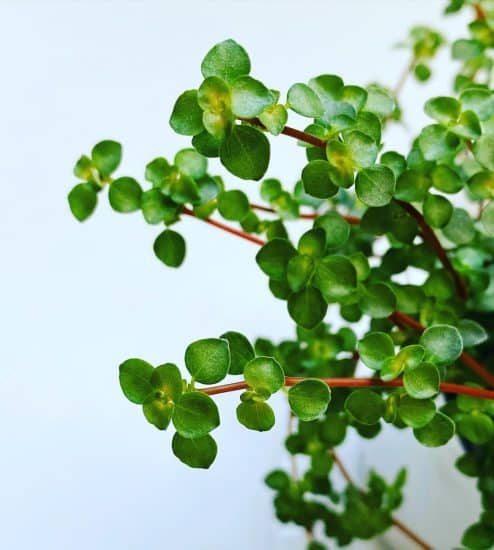
While your Pilea Glauca will bring a delightful charm to your indoor garden, it may occasionally face a few challenges.
Yellowing Leaves
When leaves start to yellow, it’s often a result of overwatering or underwatering. To figure out which issue your Pilea Glauca faces, assess the soil moisture by placing your finger about an inch into the soil.
If it’s dry to the touch, your plant likely needs more water. Thoroughly water your plant, allowing excess water to drain from the bottom, and establish a more regular watering routine.
On the other hand, if the soil is too moist, overwatering is likely the issue. In this case, let the soil dry out a bit between watering sessions and ensure your pot has proper drainage.
Leggy Growth
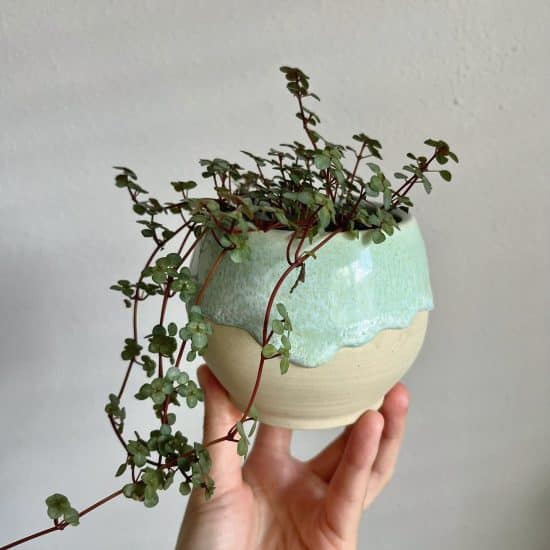
A Pilea Glauca that exhibits leggy growth is usually suffering from insufficient light, especially if it’s being improperly watered. If your plant isn’t getting enough light, it will stretch towards the light source, resulting in weak, elongated stems.
To remedy this, simply relocate your Pilea Glauca to an area with bright, indirect sunlight and keep an eye on its progress. Assess your watering routine at the same time to make sure that you’re giving your plant just the right amount of water it needs to thrive.
Pests and Diseases
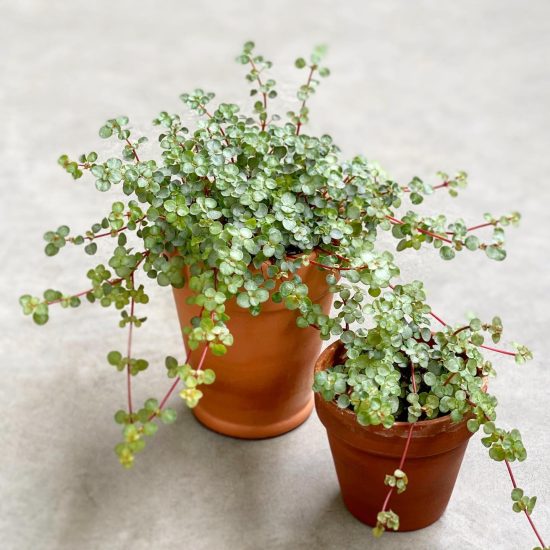
Caring for your Pilea Glauca is generally a breeze, but it’s essential to be aware of common houseplant pests and diseases that might affect your charming tropical plant.
Spider Mites, Fungus Gnats, and Thrips
Pilea Glauca might experience typical houseplant pests like spider mites and fungus gnats, so prevention is key (and much easier than treating an infestation). Consider using a neem oil spray as a protective measure and make a habit of inspecting your plant for signs of pests.
Thrips, in particular, are attracted to Pilea Glauca’s thin leaves. To spot a thrip infestation, look for these tiny insects on the leaves, along with any discoloration or curling of the foliage. If you suspect an issue, isolate your plant and treat it with insecticidal soap (following the label’s directions, of course). Monitor your plant for lingering pests after treatment.
Root Rot
Root rot happens when roots sit in overly wet soil for too long, leading to decay, which can ultimately kill your plant.
To prevent rot, provide your Pilea Glauca with well-draining soil and ensure that its pot has drainage holes. When it comes to watering, be mindful not to overdo it. Wait until the top inch or so of soil feels dry before giving your plant a drink.
If you think rot is afoot, remove the plant from its pot and examine the roots carefully. Healthy roots are firm and white or light tan in color. If you see any black, brown, or mushy roots, trim them using sterilized scissors (it’s vital to keep your tools clean to avoid spreading disease). Then, repot your plant in fresh, well-draining soil and pay close attention to its watering needs to prevent future issues.
Conclusion
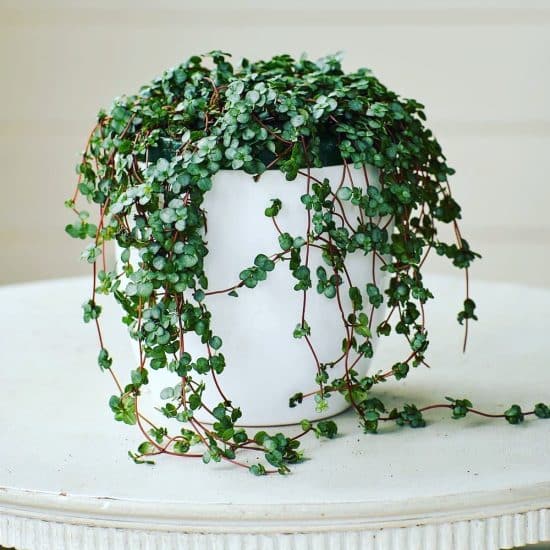
That’s it for our Pilea Glauca care guide! Whether you call it the Gray Artillery Plant, Pilea Silver Sparkle, or just plain ol’ Pilea Glauca, this plant will soon enchant you with its silvery leaves and easy-going nature.
Pilea Glauca care summary:
- Provide bright, indirect light and avoid exposing your plant to harsh direct sunlight.
- Strike the right balance in watering — keep the soil consistently moist but not soggy, and allow it to dry out slightly between watering sessions.
- Use a well-draining potting mix to prevent potential issues such as rotting roots.
If you found this guide helpful, consider sharing it with a fellow plant lover. And if you have any questions we didn’t cover, don’t hesitate to reach out — we’re here to help.
Take care, and happy gardening!
FAQ
Is Pilea aquamarine a succulent?
Pilea aquamarine, also known as Pilea Glauca, isn’t a true succulent, but it does share some characteristics with succulent plants. Its small, round leaves store water, which allows the plant to tolerate periods of drought better than some other houseplants.
Even though it’s not a succulent, pilea aquamarine still benefits from well-draining soil and a pot with drainage holes. Your Silver Sparkle Pilea doesn’t like to stand in water.
Is Pilea Glauca ‘Aquamarine’ toxic?
Pilea Glauca ‘Aquamarine’ is considered non-toxic to both humans and pets. However, it’s always a good idea to keep houseplants out of reach of children and pets, as ingesting plant material might still cause discomfort or irritation.

